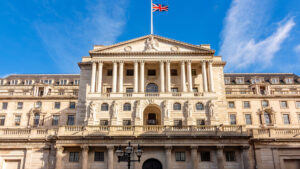Goldman Sachs has lowered its year-end target for the S&P 500 to 6,200 from 6,500, as the index erased $4 trillion in market value and almost reached correction territory.
The downgrade was made due to the growing economic uncertainties caused by trade tariffs and US economic data, which has brought major volatility to US markets. ⁽¹⁾
Why Did Goldman Downgrade?
Goldman Sachs stated that trade war escalations and growing fears of slow economic growth caused economic uncertainty. The sell-off that occurred this week was influenced by the Magnificent Seven tech stocks, which have fallen 14% from their recent highs. ⁽²⁾
Analysts from Goldman are concerned over trade tensions and the Federal Reserve’s interest rate policies, with fears pointing towards a slowdown in GDP and weak corporate earnings—something which could weigh heavily on investor sentiment.
David Kostin, Goldman Sach’s Chief US Equity Strategist, stated 3 potential influences that could drive a rally in the markets:
- Economic Growth
Economic growth expectations could revive investor sentiment if data improves or if positive developments on tariffs and trade tensions, such as new negotiations, emerge.
- Market Valuations
If the stock market approaches fair value, declines could be temporary as stocks may be more attractive at cheap prices and valuations.
- Investor Sentiment
The current bearish sentiment could prepare for a sharp reversal if market conditions improve.
Despite the downgrade, Goldman Sachs still forecasts the S&P 500 to gain 11% in 2025. ⁽³⁾
Recession Risks
Fears of a recession are rising, which could create more economic uncertainty.
Investment management firm, Pimco raised their probability forecast of a US recession in 2025 to 35%, up from 15% in December 2024, due to rising uncertainty caused by trade wars.
Despite the recession risk, Pimco still forecasts growth in the US economy between 1-1.5% in 2025. ⁽⁴⁾
Trade Wars and Market Volatility
Trump’s tariffs on all US steel and aluminum imports took effect on Wednesday, escalating trade tensions with Canada, Europe, and China. The retaliatory measures announced by major economies have stoked fears of a prolonged trade conflict that could weigh on global growth. ⁽⁵⁾
The inflation outlook remains complicated by these trade policy shifts. While February’s US consumer price index showed a modest 0.2% monthly increase and a 2.8% annual rise, the slowest since October, economists warn that tariffs could push prices higher in the future. ⁽⁶⁾
With markets still reacting to this week’s volatility, traders are preparing for more uncertainty. Key events to watch include further trade policy announcements, economic data releases, and the Federal Reserve’s stance on interest rates.
Corporate earnings in the coming months will also be critical in determining whether the S&P 500 can recover from its recent losses.


